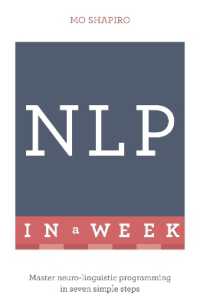- ホーム
- > 洋書
- > 英文書
- > History / World
Full Description
Combining accessible prose with scholarly rigor, The Participants presents fascinating profiles of the all-too-human men who implemented some of the most inhuman acts in history.
On 20 January 1942, fifteen senior German government officials attended a short meeting in Berlin to discuss the deportation and murder of the Jews of Nazi-occupied Europe. Despite lasting less than two hours, the Wannsee Conference is today understood as a signal episode in the history of the Holocaust, exemplifying the labor division and bureaucratization that made the "Final Solution" possible. Yet while the conference itself has been exhaustively researched, many of its attendees remain relatively obscure.
From the introduction:
Ten of the fifteen participants had been to university. Eight of them had even been awarded doctorates, although it should be pointed out that it was considerably easier to gain a doctorate in law or philosophy in the 1920s than it is today. Eight of them had studied law, which, then as now, was not uncommon in the top positions of public administration. Many first turned to radical politics as members of Freikorps or student fraternities. Three of the participants (Freisler, Klopfer and Lange) had studied in Jena. In the 1920s, the University of Jena was a fertile breeding ground for nationalist thinking. With dedicated Nazi, race researcher and later SS-Hauptsturmbannführer Karl Astel as rector, it developed into a model Nazi university. Race researcher Hans Günther also taught there. Others, such as Reinhard Heydrich, joined the SS because they had failed to launch careers elsewhere, and only became radical once they were members of the self-acclaimed Nazi elite order.
Contents
List of Figures
Foreword
Otto Dov Kulka
Introduction: The Participants: The Men of the Wannsee Conference
Hans-Christian Jasch and Christoph Kreutzmüller
Chapter 1. Biographical Approaches and the Wannsee Conference.
Mark Roseman
Chapter 2. Otto Adolf Eichmann, Reich Main Security Office: The RSHA's "Jewish Expert"
Bettina Stangneth
Chapter 3. Reinhard Heydrich, Reich Main Security Office: The Nazi Terror Enforcer
Robert Gerwarth
Chapter 4. Otto Hofmann, SS Race and Settlement Main Office. A Pragmatic Enforcer of Racial Policy?
Isabel Heinemann
Chapter 5. Dr. Rudolf Lange, Reich Main Security Office: Academic, Ideological Warrior and Mass Murderer
Peter Klein
Chapter 6. Heinrich Müller, Reich Main Security Office: The Archetypical Desktop Perpetrator
Johannes Tuchel
Chapter 7. Eberhard Schöngarth, Reich Main Security Office: A Practitioner of Mass Murder
Olaf Löschke
Chapter 8. Josef Bühler, State Secretary for the General Government. A Behind-the-Scenes Perpetrator
Ingo Loose
Chapter 9. Roland Freisler, Reich Ministry of Justice: Hitler's "Political Soldier"
Silke Struck
Chapter 10. Gerhard Klopfer, Nazi Party Chancellery: A Nationalist Ideologue and a Respectable West German
Markus Heckmann
Chapter 11. Friedrich Wilhelm Kritzinger, Reich-Chancellery: A Prussian Civil Servant under the Nazi Regime
Stefan Paul-Jacobs and Lore Kleiber
Chapter 12. Georg Leibbrandt, Reich Ministry for the Occupied Eastern Territories: An Academic Radical
Stefan Paul-Jacobs and Lore Kleiber
Chapter 13. Undersecretary Martin Luther: Defender of Foreign Office Prerogatives
Christopher R. Browning
Chapter 14. Alfred Meyer, Reich Ministry for the Occupied Eastern Territories: From German Monarchist to Nazi Desk Perpetrator
Heinz-Jürgen Priamus
Chapter 15. Erich Neumann, Plenipotentiary for the Four Year Plan: A Colorless, Compliant Prussian
Christoph Kreutzmüller
Chapter 16. Wilhelm Stuckart (1902-1953), Reich Interior Ministry: "A Legal Pedant"
Hans-Christian Jasch
Index







